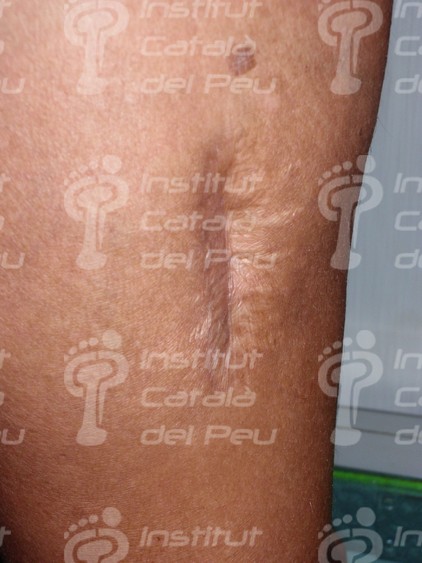The scar is a permanent dermic disturbance as a consequence of a lesion and its repair. It is made of fibrous tissue which replaces the loss of tissue and which joins the solutions of continuity.
There are four stages in the cicatrization process:
1- Inflammatory stage. Increase of the vascularization and therefore of the platelets, helping in this way the tamponing of the injury.
2- Proliferative stage. Collagen and fibrin are accumulated regenerating and tensing the injury.
3- Remodeling stage. Collagen is reabsorbed and it increases the tensile strength. It is the longest stage of cicatrization.
4- Contraction stage. The area of bloody surface decreases with the concentric reduction of the size of the injury.
The factors which stimulate the growth of the cicatricial tissue are:
- The acute treatment. The closure of the injury without tension, the control of the infection and the débridement of the injury.
- The age. There is more risk of hypertrophia of the scar among young people.
- The depth of the injury.
- The kind of skin. The red-haired people have a very high probability, followed by people with dark skin.
- Malnutrion.
- Alcoholism and nicotine poisoning.
The scars can have cosmetic surgery and functional problems for the patient.
The scars are classified in five kinds:
- Hypopigmented scar. The scar has a lighter color than the rest of the skin because of the disability to produce melanin in this area due to the traumatism caused.
- Hyperpigmented scar. The scar is darker and it appears in superficial scars. It is a consequence of a bigger degree of melanogenesis together with the repair inflammatory process.
- Hypertrophic scars.
- Cheloid scars.
- Another kind of scars, like for example, retractile scars, atrophic scars, etc. This sort of scars are located slightly in the depth of the skin regarding the cutanenous surface by a lack of formation of enough tissue to cover the injured It is typical of acne or chicken pox.
The hypertrophic scar is located in the traumatic area of the initial injury without invading the adjacent tissues. Its growth starts after the closure of the injury and it can continue to hypertrophy until 8 months. The causes are due to mechanical factors, young ages, infections of the injury, as well as the anatomical location.
The cheloid scar covers beyond the initial injury as a consequence of the anomalous formation of collagen in order to revitalize the connective tissue after the lesion.
It is less common than the hypertrophic scars. It starts to grow at the beginning of traumatism after one year and it can go on growing without a sign of stabilization. It appears more frequently in people of dark race, young women, pregnant women and in anatomical areas like the neck, shoulders, the lobe or the sternum area. It has a tonality of flesh-colored, pink or red and it appears as a consequence of traumatisms, surgical injuries, burns, chicken pox, etc.
The cheloid scars don’t usually get better in a spontaneous way while hyperthophic scars can get better in an aesthetic way without any treatment.
The most frequent treatments against the cheloid scars are the radiotherapy, the cryotherapy, the laser treatment, the infiltrations of corticosteroids which will reduce the inflammation, as well as the cosmetic surgery. We have to take into account that such treatments reduce the size of the cheloid scar and it doesn’t disappear totally in most of the cases. The criterion of choosing one treatment or another will depend on the sort of scar and always considering the connection between the advantages and the risks.
Hypertrophic scar by hallux valgus operation.
Hypertrophic scar by traumatism.
Hypertrophic scar by traumatism.
Postsurgery hypertrophic scar.
Hypertrophic scar.
Hypertrophic scar by traumatism.
Plantar scar by autolesion when removing a callosity.
Postsurgery scar by exeresis. Benign tumor.
Same example with bipedestation. Watch the lack of adjacent tissue.
Cheloid scar.
